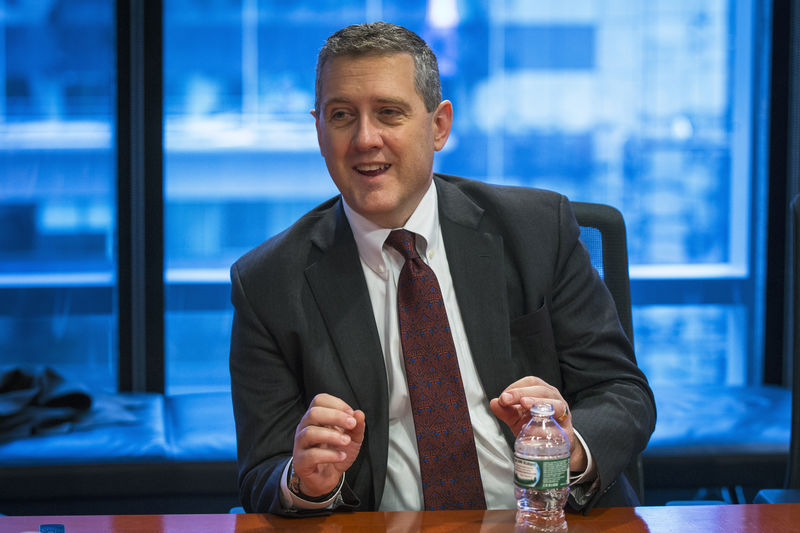 © Reuters. St. Louis Fed President James Bullard speaks about the U.S. economy during an interview in New York
© Reuters. St. Louis Fed President James Bullard speaks about the U.S. economy during an interview in New YorkBy Howard Schneider
ST. LOUIS (Reuters) – For nearly two years the U.S. Federal Reserve has pushed ahead with steady rate increases in an economy that has done better than expected, boosted by government spending, tax cuts, and global growth that made the Fed’s policy choices seem almost a footnote.
The easy part may be over, St. Louis Federal Reserve President James Bullard said in an interview here, as possible “cracks” in the U.S. recovery begin to shape the central bank’s debate over where the Fed stands in a rate-rise cycle that began in December 2015, and how much further it should go.
As previous Fed rate increases start to curb mortgage and other markets, and the stimulus of tax cuts and government spending begins to fade, the Fed may face a year of difficult decisions, with rates still low by historic standards but growth ebbing.
“Whether there are cracks in the U.S. economy’s performance is one of the main challenges for the Fed going forward,” said Bullard. “I don’t have any reason to doubt the economy will slow in 2019 and 2020. It would be much tougher for the Fed to continue to raise at this pace in a slowing economy relative to where we have been.”
The Fed has raised rates six times in the past two years, with an increases expected later this month as well.
The last two years have been “roses” for the U.S. and world economies, Bullard said, with U.S. growth expected to exceed 3 percent for the year in 2018. He said he feels the economy and job market both remain strong.
But he said it is likely that the country’s longer-term trend growth of 2 percent or slightly less will resume.
That has become an emerging theme at the central bank.
In September, Fed Chairman Jerome Powell rhapsodized about an economy where low unemployment, low inflation, and steady growth would persist. A few weeks later new volatility had wiped out the year’s stock market gains, concerns had taken root about global growth, and U.S. data showed weakness in the housing market and business investment.
Indeed, Fed policymaker projections expect growth of 2.5 percent next year compared to 3.1 percent this year.
Those same projections also show rates continuing to increase three times in 2019 in addition to an expected hike in December, an outlook that Bullard said begs a more fundamental question: If growth slows, inflation remains around the Fed’s two percent target, and the labor market is strong, what’s the need for higher rates?
“The good news won’t last forever, and if potential growth really is at 1.8 percent the economy is going to return to some level more like that,” said Bullard. “The question in my mind is what are we trying to control? We have already been preemptive…We took all this action and it has put us in good shape,” with inflation near target and market expectations about inflation perhaps even a bit weak.
The Fed’s eight increases since late 2015 have set the federal funds rate at a range of between 2 and 2.25 percent, which Bullard regards as already near a neutral level that is no longer encouraging spending and investment.
Move rates higher, absent an unexpected acceleration in growth, and policy would start to become restrictive. The core Fed view is that the neutral rate is somewhat higher, and that rate increases are likely to be warranted into 2020, to as high as 3.4 percent.
Bullard will be a voter on Fed policy beginning in January, and in a position to formally dissent against further rate increases. He has been making the case for roughly two years that the United States was stuck in a low-rate, low inflation and low productivity rut, and that rates needn’t rise until something changes.
He acknowledges the last two years have challenged that view – and in fact said that had he been voting on interest rates over that period he would have supported increasing them.
But that’s only because the unexpected happened, owing to the run up in confidence and investment that followed the 2016 election, improved overseas growth, and the jump in federal government spending that lifted growth at least in the short term.
Next year may look quite different.
“If we had not had these surprises to the upside my story would have looked better in retrospect than it does,” Bullard said. “As a baseline most forecasts have the economy slowing down…That is the basic structure we are working with going into 2019.”
Source: Investing.com




























